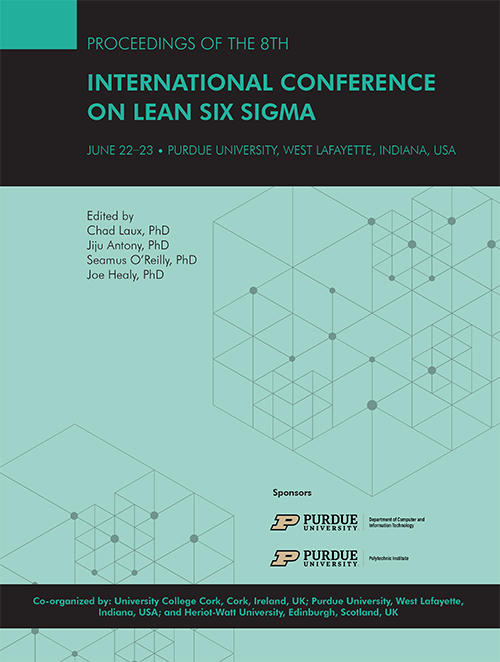DOI
10.5703/1288284317341
Abstract
Abstract
This research highlight the different aspects of implementing lean and six-sigma approach, their contrasting features and integration in manufacturing organizations. Qualitative research method has been used to conduct this research as the defined period of time for the research was limited. This method was pertinent for the deep analysis of literature and case studies of concerned approaches. It helped to conduct the research in a subjective manner. The use of secondary data saved time from preparing the questionnaires or surveys also the ethical approval from the University of the West of Scotland was not required. Descriptive feature of qualitative research was germane to gather substantial information of related topic from different legitimate resources. For the collected data analysis, Deductive scientific approach has been applied. This research does not make use of any statistical tools for data analysis.
Literature studies reveal that Lean Six Sigma has been mostly frequently used in service organization in comparison of manufacturing industries. It has been observed that the Implementation of Lean Six Sigma gave an amalgam of advantages of both approaches when deployed together in terms of cutting down the cost of production, decreasing process variations, lower process waste and effective resource management.
This research was limited by few factors as the time-frame was not enough to cover up every aspect of the selected topic. Moreover, six case studies were found not to be enough to generalize the model for Lean Six Sigma implementation because there is a possibility of a manufacturing organization of different nature that may not be covered in the research. Furthermore, the concluded concepts shall be applicable only for manufacturing organizations. Adding to this, the research methodology was not enough to add up to the data collection skills of the researcher.
For future studies there is a need to fill the research gap by using quantitative research method to analyze the impact of Lean and Six Sigma integration on process value chain. Future researchers can also take up the service organizations as a subject matter for an extensive research.
Keywords
Lean; Six Sigma; Integration; Manufacturing Industries
Included in
Higher Education Commons, Industrial Engineering Commons, Operations and Supply Chain Management Commons, Systems Engineering Commons
SIX SIGMA AND LEAN APPROACH FOR ENHANCED PROCESS VALUE CHAIN
Abstract
This research highlight the different aspects of implementing lean and six-sigma approach, their contrasting features and integration in manufacturing organizations. Qualitative research method has been used to conduct this research as the defined period of time for the research was limited. This method was pertinent for the deep analysis of literature and case studies of concerned approaches. It helped to conduct the research in a subjective manner. The use of secondary data saved time from preparing the questionnaires or surveys also the ethical approval from the University of the West of Scotland was not required. Descriptive feature of qualitative research was germane to gather substantial information of related topic from different legitimate resources. For the collected data analysis, Deductive scientific approach has been applied. This research does not make use of any statistical tools for data analysis.
Literature studies reveal that Lean Six Sigma has been mostly frequently used in service organization in comparison of manufacturing industries. It has been observed that the Implementation of Lean Six Sigma gave an amalgam of advantages of both approaches when deployed together in terms of cutting down the cost of production, decreasing process variations, lower process waste and effective resource management.
This research was limited by few factors as the time-frame was not enough to cover up every aspect of the selected topic. Moreover, six case studies were found not to be enough to generalize the model for Lean Six Sigma implementation because there is a possibility of a manufacturing organization of different nature that may not be covered in the research. Furthermore, the concluded concepts shall be applicable only for manufacturing organizations. Adding to this, the research methodology was not enough to add up to the data collection skills of the researcher.
For future studies there is a need to fill the research gap by using quantitative research method to analyze the impact of Lean and Six Sigma integration on process value chain. Future researchers can also take up the service organizations as a subject matter for an extensive research.
Keywords
Lean; Six Sigma; Integration; Manufacturing Industries






